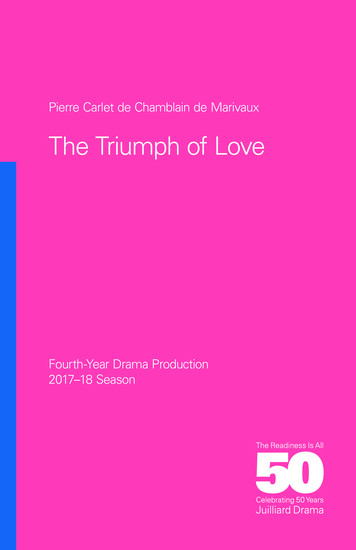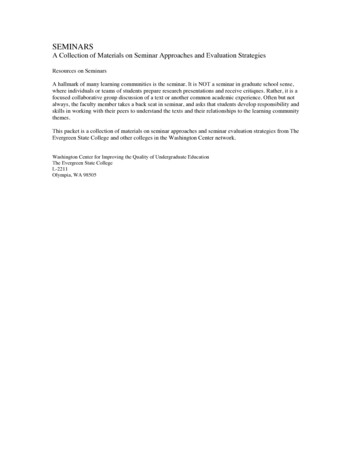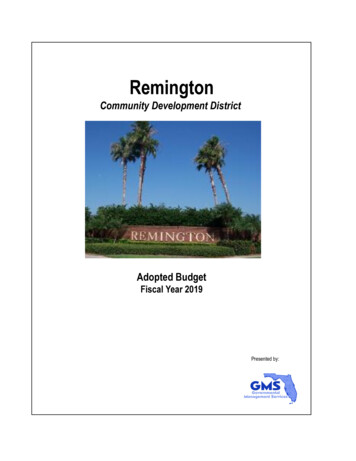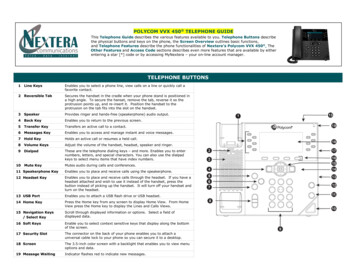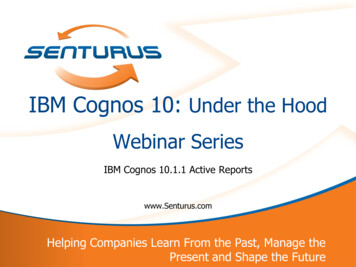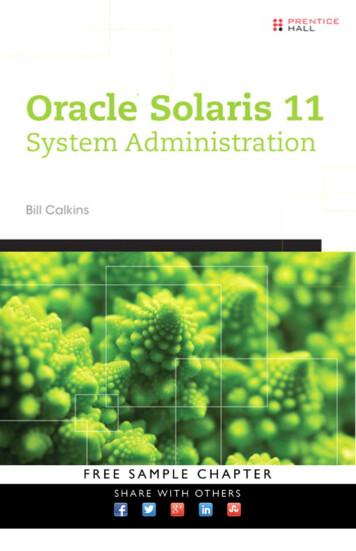
Transcription
RELS 450 Senior Seminar on Religion, Conflict & Violence (MW 4-5:15 MYBK 119)Dr. Zeff BjerkenDept. of Religious StudiesCollege of CharlestonOffice: RELS Building, 4A Glebe Street, room 101Office hours: Mon. 9:30-11:30; Tue. 11-12; Wed. 1-2 pmOffice phone: 843-953-7156 e-mail: bjerken@cofc.eduCourse DescriptionReligious violence is a slippery topic, one that is sensitive, complex, potentially offensive, but of majorimportance. Defining “religion” is notoriously difficult. Defining “violence” turns out to be just as tricky.Due to the nature of the topic, then, this seminar will be exploratory in nature. This course will providestudents with critical tools from a variety of disciplines within the field of Religious Studies to makesense of recent events in our world when religion became intertwined with racism, nationalism, and thepreservation of ethnic identities, for these toxic combinations can result in tragic violence. We will rely ona variety of methods to examine instances of violence and reconciliation, including ethnography, socialpsychology, rhetorical analysis of religious speech, gender and ritual studies, and the history of religions.As case studies, we will examine Hindu-Muslim conflicts in modern India, conflicts betweenChristian evangelicals and African animists, terrorism and the “war on terror” after 9/11, and theescalating role of religious rhetoric in American politics today. As we inquire into the history, causes, andcharacteristics of religious violence, none of us should expect to leave the class with a definitiveexplanation or solution for it. There are no clear “right answers” that cannot be questioned. What we cando, however, is place acts of religious violence in their proper context, and learn to ask questions andexplore different means to answer those questions. What might some of those questions be?There are many possible starting points and you will undoubtedly bring your own questions andideas with you. We will initially organize our inquiry around the following: Why do individuals involvedin terrorism rely so heavily on religious texts and traditions to justify vengeful ideologies? Does violencerepresent an aberration born of human weakness or is it the inevitable result of religion? What is thelogic that provides moral justifications for violence? What does it mean to “understand” something thatwe find morally reprehensible or simply bizarre? What is the proper balance between empathy andcritical judgment for the scholar of religion? Should scholars of religion be neutral detached observers orserve as cultural critics in the public arena?Seminar Goals and Student Learning Outcomes To re-examine “religion” as a modern constructed category and interrogate its intersection withpower, race, ethnicity, gender, sexuality, and class (“intersectionality”) To apply a variety of critical theories to different religious contexts in order to better understand theviolence in our world (this should make you a much more informed consumer of the news media) To foster a reflexive awareness of how scholars’ methods and theoretical presuppositions (includingyour own) have informed the way in which religion is understood To hone your critical reading, thinking, and writing skills through disciplined engagement with texts,short essay assignments, and a research writing project To improve how you speak with clarity, precision, and depth about complex and controversial topicsThere are Four Required Texts available at the CofC Barnes & Noble Bookstore: Mark Juergensmeyer, Terror in the Mind of God (4th edition 2017) 29.95 Barbara Kingsolver, The Poisonwood Bible: A Novel P.S. (Harper edition) 19 Bruce Lincoln, Holy Terrors: Thinking about Religion after September 11 (2nd edition, 2006) 20 Shashi Tharoor, Riot: A Love Story (Norton edition, 2011) 14.95 There are also required Electronic Readings (ER#1-22), pdf of articles by scholars and formerstudents available on OAKS, which registered students can access and download after they login toMyCharleston (http://my.cofc.edu) under RELS 450. Please print out each article and bring it toclass on the day that it will be discussed.!1
RELS 450 Senior Seminar on Religion, Conflict & Violence (MW 4-5:15 MYBK 119)Course RequirementsThis is a seminar, not a lecture course, and participants are expected to do all the required readings foreach class. Seminar participation is crucial for success in the class, and the discussion board assignment isdesigned to encourage completion of the assigned reading before we meet. Active participation in seminar, including a class presentation (20%)Asking questions, raising concerns, and offering your own ideas during seminar discussions is acrucial part of this course. You are expected to be an active participant in class discussions. Grades forclass participation will be assigned on the basis of the quality and consistency of your involvement inclass discussions, including those provoked by other students’ comments. Each student will berequired to do a class presentation (5%) on their research project towards the end of the semester.Discussion Board (20%) Discussion posts on OAKS should re-articulate the reading’s mostimportant point in our own words and also pose a question raised by the reading for class discussion.The controversial subject matter of this course can provoke anger, shock, and disagreement in you, allof which you can note in your posts, but I’m also looking for new insights, new ways to contextualizeand critique what you’ve read. Preparing in this manner will enable us to move our discussions alongin a lively and interesting way. You will post on our discussion board by 11:59 am prior to each class.Two 4-page essays due 9/25 and 10/16 (15%) There will be two critical essays that apply some oftheories we have studied to the two novels that we will read, namely Riot and Poisonwood Bible.Grades will be based on accuracy, analytic insight, and clarity of organization and expression.Term Research Paper of 12-15 pages (45%): For this research paper you will be required to applyone theoretical perspective and a method learned from those studied in seminar to some currentcontroversy that features religion, politics, identity and violence. A one-page description with researchquestions is due October 23 (5%); an annotated bibliography is due October 30 (5%); a completedraft of the paper is due on November 13 (15%); the final revised draft is due December 7 (20%).Grading ScaleA 100-93 (4.0)A- 92-90 (3.7)B 89-87 (3.3)B 86-83 (3.0)BC CC-82-80 (2.7)79-77 (2.3)76-73 (2.0)72-70 (1.7)D 69-67 (1.3)D 66-63 (1.0)D- 62-60 (.70)F 59-lower (0)TechnologyUse of cell phones in class is strictly prohibited; please turn off your cell phone when you enter class.Students are expected to have a CofC email address linked to OAKS that they check regularly. Email ismy most frequent and effective means of communication. Since technology can fail, technical difficultiesare not acceptable excuses for late assignments or missed class. I expect you to complete assignmentswell enough in advance to factor in these variables and remember, so always back up your documents.Academic Integrity and Learning ResourcesThere is a zero-tolerance policy toward plagiarism or any other form of academic dishonesty in thiscourse. This means that anyone caught taking credit for work that is not his or her own will receive afailing grade for the course. A student found responsible for academic dishonesty will receive a XXFgrade, indicating failure of the course due to academic dishonesty.Students may utilize the Center for Student Learning’s (CSL) academic support services for assistancein study strategies and course content. They offer tutoring, supplemental instruction, and study skillsworkshops. I encourage you to take advantage of the Writing Lab in the Center for Student Learning(Addlestone Library, first floor). Trained writing consultants can help students develop their writingskills; they offer one-to-one consultations that address everything from brainstorming to identifying anddefending a thesis statement. For more, visit http://csl.cofc.edu/labs/writing-lab!2
RELS 450 Senior Seminar on Religion, Conflict & Violence (MW 4-5:15 MYBK 119)I.Studying Religion & Violence: Introduction to the major themes and debates8/21Introduction to Course Requirements and Themes(Discuss Syllabus and clips from “7 Days in September” documentary film)8/26How and why do we associate “religion” with “violence?”(ER#1-2: “Is Religion the Problem?” and “The Violence of Illusion”)Seminar topics: What important insights do Juergensmeyer & Sen offer us about religion, identity, and violence?If religion has been linked to violence, then why is Juergensmeyer reluctant to conclude that religion is the source ofviolence? Sen writes about the “freedom to determine our loyalties and priorities.” Would religious folks like Hindusand Muslims feel free to choose their identity? Why or why not?8/28Is the claim that religions are “violent” a “myth?”(ER#3-4: “Does Religion Cause Violence?” and “Religions are Intrinsically Violent”)Clips from PBS Frontline documentary, “Faith and Doubt at Ground Zero”Seminar topics: How does the distinction drawn between the “religious” vs. the “secular” causes of violence tell usabout the boundaries of “religion?” When you consider why “religion” is connected with violence, can you identifyany reasons beyond the three that Cavanaugh identifies, namely that “religion is absolutist, religions is divisive, andreligion is irrational”? According to Sheedy, what assumptions about “religion” are made by those who arecommitted to “secular rationalism?”II.9/2Hindu and Muslim Conflicts in IndiaThe Indian Religious Context: Competing Hindu Memories of the Past(ER#5: “Introduction” and “Religious and Spiritual Life;” and ER#6: “The Setting”)Seminar topics: What values do the Hindu nationalist and flexible Hindu share (according to ER#5), and how dothey differ? “The Setting” begins with a very disturbing image of a young girl that haunts Kakar’s imagination;what does this image tell us about the limits of empathy and his role as a psychoanalyst? Kakar then distinguishesbetween the Indian secularist and Hindu nationalist representations of the history of Hindu-Muslim relations. Whatare the key ideological points found in each form of historiography? What is problematic about each viewpoint?Which historical perspective comes closer to the truth in your estimation?9/4The Rhetorical Magic of Demagogues: Hindu and Muslim Stereotypes of the “Other”(ER#7-8: “Conflict: Hindus and Muslims” and “Search for Hindu-ness”)Seminar topics: How is an enduring Hindu identity identified? Is it new or old, both or neither? Is it a manifestationof group narcissism? Why do Hindus need Muslims for their nationalist agenda, while Muslims do not need Hindusfor theirs, according to Kakar? How does the powerful rhetoric and political “magic” of the Hindu demagogue,Rithambara (ER#8), tap into the subconscious fears and wishes of her audience? How does her celebration of Hindu“tolerance” turn Muslims into scapegoats?9/9Why Guys Throw Bomb: Empowering Marginal Men with Warrior Power(Terror in the Mind of God, chapter 5: “Warriors’ Power” and ER#9: “The Warriors”)Seminar topics: Juergensmeyer writes the following about men who engage in religious violence: “What they havein common, these movements of cowboy monks, is that they consist of anti-institutional, religio-nationalist, racist,sexist, male-bonding, bomb-throwing young guys. Their marginality in the modern world is experienced as a kind ofsexual despair that leads to violent acts of symbolic empowerment. It could almost be seen as poignant, if it were notso terribly dangerous.” (255) Do these insights into the causes of religious violence apply to Kakar’s description andanalysis of Indian wrestlers (pelhwan) in ER#9? How does the assertion of macho masculinity and the recovery ofpublic virility relate to the ideology of Hindu nationalism?9/11Machismo and Mobs: Collective Effervescence or Toxic Masculinity?(ER#10: “The Riot”)Seminar topics: What stands out to you about Kakar’s childhood memories of the religious violence that resultedfrom the Partition of Pakistan and India? When religious processions turn violent, does the mobs’ ecstaticexperience qualify as a “religious” moment of self-transcendence and collective effervescence? How is violencebetween Muslims and Hindus explained in the film Father, Son, and Holy War?!3
RELS 450 Senior Seminar on Religion, Conflict & Violence (MW 4-5:15 MYBK 119)9/16Introducing Riot: Coca-Colonialism, Love & the Death of an American Woman(Riot: 1-63)Seminar topics: “We have given passports to a dream, a dream of an extraordinary, polyglot, polychrome,polyconfessional society. But who allowed for militant Hinduism to arise, challenging the very basis of theIndianness I’ve just described to you?” asks Laxman. How does the Hindu militant Ram Charan Gupta challengeLaxman’s secular and pluralistic ideals of Indian democracy? When Gupta voices his own perspective,what echoes do you hear of Kakar’s Hindu subjects?9/18Reading Riot: Intertwining Love and Lust, Hate and History(ER#11: “Contemporary Sexuality;” continue reading Riot, in whatever order of events you wish)Seminar topics: Riot presents a sharp contrast between the two lovers Priscilla and Laxman, and their attitudestowards sexuality and public displays of affection. How does each reflect distinct cultural norms about sexuality,gender, selfhood, and power? Why does control of the body and sexuality generate such strong moral and religiousfeelings that are then expressed in a language of virtue and vice, sin and redemption? What collisions of cultures,religions, race and class occur in this novel?9/23Cross-Cultural Clashes and Political Polemics in Riot(ER#12: “Clash of Civilizations?” and continue reading Riot)Seminar topic: Why might Huntington’s “clash of civilization” theory (ER#12) be so appealing? Is there a singular“Hindu civilization” distinct from an essential “Muslim civilization?” Does this theory reinforce the ideologicalinterests of religious nationalists? Does it help to clarify the conflict between Hindus and Muslims that we’ve readabout in Riot or in earlier readings?9/25Post-modern Plots: Is the riot and the murder unknowable?(Wrap up Riot)III.Missionaries Encounter the “Other” in Africa: Words about the Word9/30Missionaries, Colonialism, and the Study of Religion in Africa(ER#13: “Frontiers of Comparison” and Poisonwood Bible: Genesis)Essay #1 on Riot due: On pp. 136-7 Laxman describes to Priscilla his dream of writing a book about religionwithout an omniscient narrator, a book of interconnected events that can be read in whatever order the reader wishesto reveal that Truth is “elusive, subtle and many-sided.” How successful is Tharoor in writing a mystery with a plotthat cannot be completely unraveled about a murder and a riot that can never be completely known? Is truth reallyunknowable and subjective in this novel, or can we explain some of the causes for the riot by drawing upon RELStheories? Do all of the antagonists believe themselves to be in sole possession of “the truth,” including Laxman?Seminar topics: According to ER#13 there are three phases in the history of the study of African culture/religions;how does each phase manifest colonial interests and the desire for control of African subjects? How is the foreign inAfrica made more familiar to the western colonizer? In Poisonwood Bible what themes from the Old Testament areused in telling the family’s story? What are the implications of the “poisonwood bible” in the title?10/2The Poisonwood Bible: Revelations about Race in Africa(ER#14:“Race and Religion;” Poisonwood Bible: The Revelation)Seminar topics: How does ER#14 shed light on the racist baggage brought from Georgia to Africa, e.g. when RuthMay says “God says the Africans are the Tribes of Ham?” How does Kingsolver differentiate among the Price sistersin terms of their voices and attitudes towards their religious mission in Africa? What differences and similarities arethere among Nathan Price’s relationship with his family, Chief Tata Ndu’s relationship with his people, and therelationship of the Belgian and American authorities with the Congo?10/7The Rhetoric of Fundamentalist Preachers & the Magical Power of Naming in an Animist Culture(ER#15: “Speaking is Believing;” Poisonwood Bible: The Judges)Seminar topics: According to ER#15, what are the rhetorical strategies used by Baptist ministers to fosterconversion to the Word? Language is vitally important in Kingsolver’s novel: misused words fill the interiormonologues of both Rachel and her little sister Ruth Ann, and the central metaphor of the novel features ReverendPrice’s attempt to disseminate the Word in the language of Kikongo: “Tata Jesus is Bängala.”What is the significance of the Kikongo word nommo and its attendant concepts of being and naming?Are there Christian parallels to the constellation of meanings and beliefs attached to nommo?!4
RELS 450 Senior Seminar on Religion, Conflict & Violence (MW 4-5:15 MYBK 119)10/9Poisonwood Bible and Mimetic Violence(ER#16: Violence & Religion: Cause or Effect?” Poisonwood Bible: Bel and the Serpents)Seminar topics: Do you find Girard’s theory about mimetic desire and mimetic rivalries a convincing way toexplain religious violence? Does scapegoating a victim for ritual sacrifice help us to understand events in thePoisonwood Bible?10/16 Revelations from The Poisonwood Bible: Understanding the “Word” and World in AfricaEssay #2 due: What do you consider the most important lessons learned by Orleanna and the Price girls about thelanguage and religion of the Congo? What “revelations” do they learn about themselves, their earlier assumptionsabout Africa, and their religious mission there once they begin to listen to the voices and learn the language of theCongolese? Finally, what lessons can we learn from the novel about the study of other religions?IV.Rethinking Terror, Violence and the “Culture Wars” in America After 9/1110/21 “In God We Trust”: Civil Religion and America’s Mission in the World(ER #17-18: “Civil Religion in America” and “To Blood Sacrifice and the Nation”)Seminar topics: Is the analysis of American “civil religion” (in ER#17) a neutral description or an endorsement?Does civil religion provide the State with religious legitimation for war? Does America have a special historicmission to liberate the whole of humanity from bondage? Is the argument made in ER#18, in support of the claimthat “nationalism is the most powerful religion in the United States,” but that “citizens of nation-states have religiousreasons for denying it,” appear convincing to you? Would Cavanaugh (in ER#3) agree with their point?10/23 Theorizing Violence and Terror(Terror in the Mind of God, xiii-xvii, 1-15, 29-39; ER#19: Michael Bray) Term paper topic dueSeminar topics: How is Juergensmeyer’s cultural approach to the study of religious terrorism different fromHuntington’s clashing civilizations model? Does a “war on terrorism” create more religions of rebellion?Are the Christians who justify their acts of violence acting in defense of the American status quo or in revolutionagainst it? Bray appeals to a divine mandate for righteous violence (with God as wrathful warrior) to justify the actsof Christian “soldiers” who attack abortion clinics. What do we make of his use of the American revolution and tothe anti-slavery abolitionists during the Civil War to justify his position?10/28 Onward Christian Soldiers: Images of Terror at Abu Ghraib(Terror in the Mind of God, pp. 19-29; ER#20: “Torture at Abu Ghraib”)Seminar topics: Why do the images of Abu Ghraib require context to understand what their “meaning” is?Are there contexts that seem absent in the analysis of these images? After viewing the images and reading ER#20,does this instance of our government’s “war on terror” seem “secular” or “religious?” Why is this distinction soproblematic? How do scholars like Kakar, Cavanaugh, and Juergensmeyer help clarify what is at stake at AbuGhraib? (Note: ER#20 as written by a former student in RELS 450 and it serves as a model term paper!)10/30 Redefining Religion and Understanding the Spiritual Manual of the Suicide Bombers(Holy Terrors: 1-18; 93-98; ER#21: “Defining the Present Situation of Muslims”)Annotated bibliography dueSeminar topics: According to Lincoln, what is wrong with labeling the hijackers as “evil-doers?” Should weabandon the “F” word “(Fundamentalism) in favor of “religious maximalism?” Is religion most vital when it is inconflict with mainstream or surrounding cultures? What would motivate the American mainstream media and the9/11 Commission to disregard the Spiritual Manual, a manual that prescribed how the hijackers ought to performrituals of purification and recite prayers? How does the Manual allow us to understand the motivation of thehijackers in their quest for martyrdom?11/4Cosmic Wars: When Symbols Become Deadly(Terror in Mind of God chapters 7-8: “Theater of Terror” and “Cosmic War”)Seminar topic: Do the events of 9/11 support Juergensmeyer’s generalizations about ritualized violence performedin a “theater of terror?” Are the acts of terror by the hijackers more important for their symbolic value than forachieving any strategic goal? Does an appeal to the “symbolism” of cosmic warfare, which need not result in acts ofviolence, require that we make distinctions between “actual” vs. “potential” violence, or private “inner” vs. public“outer” religiosity?!5
RELS 450 Senior Seminar on Religion, Conflict & Violence (MW 4-5:15 MYBK 119)11/6Symmetric Dualisms: Analyzing the Rhetoric of Bush and Bin Laden(Holy Terrors: 19-32, 99-103). Thesis Statement and first paragraph dueSeminar topics: What are some of the dualisms shared by Bush and Bin Laden? How does the basis for theirauthority (whether religious or secular) produce different rhetorical styles in their public speeches? Can we clearlydistinguish between “religious” vs. “political” motivations when we examine President Bush’s policies?The Long Shadow of 9/11: Our “Culture Wars”11/11The Jeremiads of Jerry & James (Falwell & Dobson)(Holy Terrors: 33-61, 104-107; ER#22: “SpongeBob and the Emasculating Arm of Flesh”)ER#22 was written by a former RELS major in the Senior Seminar and it serves as a model term paper!Seminar topics: When Jerry Falwell stated that liberal secularists in America (feminists, abortionists, gays andlesbians) made God mad, which resulted in the attacks of 9/11 on American soil, how does this mobilize anevangelical Christian revival? How does James Dobson’s campaign against SpongeBob as a “gay conspiracy”reflect his larger claim that evangelicals are “victimized” in our culture today? Are leaders like Falwell and Dobson,who protest against “deviant” sexuality and gender roles in today’s society, fomenting a patriarchal protestmovement? How do scholars like Lincoln, Kakar and Juergensmeyer help clarify what is at stake in these “culturewars,” where the “warriors” make tactical moves in their “struggle” to reclaim God’s territory?11/13Student research presentations; complete draft of research paper due11/18Student research presentations11/20Student research presentations11/25Student research presentations12/2Healing Politics with Religion(Terror in the Mind of God chapter 11: “The Mind of God”)Seminar topics: What role might theology and ritual play in healing radical religious violence? Is ritualizedviolence (such as sacrifices or the Crucifixion) cathartic? Does RELS theory about violence and terror only dealwith abstractions and arise from too much “distance” from the real lives of religious folks? How can we empathizewith and understand the religious lives of others yet retain the capacity for moral judgment?12/6Final Draft of Term paper due by 7 pm12/15 SECSOR Undergraduate Essay deadlineStudents at institutions in the Southeast Region are invited to submit papers for the Undergraduate Sessions,sponsored by SECSOR. Open to all topics, the sessions will be composed of the papers considered the bestsubmissions by an interdisciplinary committee. Students should submit completed papers that reflect original studentresearch of an appropriate length for presentation (approximately 12 double-spaced pages). No paper over 14double-spaced pages, regular size font, will be considered; one submission per student. On a cover page, pleaseinclude contact information for the student and for the faculty sponsor who has reviewed the submission. Papers inWord or PDF format are to be emailed to secsor.undergraduate.section@gmail.com no later than December 15.All undergraduate papers are automatically considered for the Undergraduate Paper Prize.2/28-3/1SECSOR Conference, Athens GA!6
RELS 450 Senior Seminar on Religion, Conflict & Violence (MW 4-5:15 MYBK 119)RELS 450 Electronic Readings on OAKS1. Mark Juergensmeyer, “Is Religion the Problem?” Hedgehog Review 6.1 (2004), pp. 21-33.2. Amartya Sen, “The Violence of Illusion” from Identity and Violence: The Illusion of Destiny (NewYork: Penguin, 2006), pp. 1-173. William Cavanaugh, “Does Religion Cause Violence?” in Harvard Divinity Bulletin, vol 25 no. 2-3,(Spring/Summer 2007), 22-35.4. Matt Sheedy, “Religions are Intrinsically Violent” from Stereotyping Religion: Critiquing Clichés ed.by Brad Stoddard and Craig Martin, New York: Bloomsbury, 2017, pp. 23-39.5. Sudhir and Katharina Kakar, “Introduction” and “Religious and Spiritual Life” from The Indians:Portrait of a People. Delhi: Penguin Books India, 2009, pp. 1-6; 134-151.6. Sudhir Kakar, The Color of Violence: Cultural Identities, Religion, and Conflict. Chicago:University of Chicago Press, 1996, pp. pp. 1-4, 12-24.7. Sudhir & Katharina Kakar, “Conflict: Hindus and Muslims” from The Indians, pp. 152-179.8. Sudhir Kakar, “Search for Hindu-ness” from The Color of Violence, pp. 152-169.9. Sudhir Kakar, “The Warriors” from The Color of Violence, pp. 52-59, 80-86.10. Sudhir Kakar, “The Riot,” from The Color of Violence, pp. 25-51.11. Sudhir & Katharina Kakar, “Contemporary Sexuality” from The Indians, pp. 84-106.12. Samuel Huntington, “The Clash of Civilizations?” Foreign Affairs (Summer 1993), pp. 22-41.13. David Chidester, “Frontiers of Comparison,” from Savage Systems: Colonialism and ComparativeReligion in Southern Africa. Charlottesville: University of Virginia Press, 1996, pp. 1-29.14. Malory Nye, “Race and Religion: Postcolonial Formations of Power and Whiteness,” in Method andTheory in the Study of Religion (2018) pp. 1-28.15. Susan Friend Harding, “Speaking is Believing” from The Book of Jerry Falwell: FundamentalistLanguage and Politics. Princeton University Press, 2000, pp. ix-xii; 33-60.16. Rene Girard, “Violence & Religion: Cause or Effect?” Hedgehog Review 6.1 (Spring 2004), pp. 8-20.17. Robert N. Bellah, “Civil Religion in America,” Daedulus: Journal of the American Academy of Artsand Sciences 96.1 (Winter 1967), pp. 1-21. Downloaded from: www.robertbellah.com/articles 5.htm18. Carolyn Marvin and David W. Ingle, “Blood Sacrifice and the Nation: Revisiting Civil Religion”Journal of the American Academy of Religion Vol. 64. no. 4, (Winter 1996), pp. 767-780.19. Michael Bray, “A Time for Revolution?” in Princeton Readings in Religion and Violence, ed. byMark Juergensmeyer and Margo Kitts (Princeton University Press, 2011), pp. 55-61.20. Katie Browne, “Torture at Abu Ghraib: The Terrorist Tactics of a Modern Democracy and theOppression of the Muslim “Other,” Chrestomathy: Annual Review of Undergraduate Research at theCollege of Charleston vol 7. (2008), pp. 22-35.21. Hans G. Kippenberg, “Defining the Present Situation of Muslims and Re-Enacting the Prophet’sGhazwas” in The 9/11 Handbook ed. by Kippenberg and Tilman Seidensticker (London: Equinox,2006), pp. 47-58.22. Chelsea Diffendal, “SpongeBob SquarePants and the Emasculating Arm of Flesh,” Chrestomathy:Annual Review of Undergraduate Research at the College of Charleston vol. 4 (2005), pp. 46-64.Resources on Religion and Politics in Current Events1.2.3.4.5.6.7.Religion News Service: https://religionnews.comThe Revealer: www.therevealer.orgReligion Dispatches: https://rewire.news/religion-dispatchesKilling the Buddha: http://killingthebuddha.com/Immanent Frame: https://tif.ssrc.orgAlt.Muslim: Interactive News for the Muslim Community: www.altmuslim.comChristianity Today: www.christianitytoday.com8. Soujourners: Faith, Politics, Culture: www.sojo.net/index.cfm?action magazine.home!7
RELS 450 Senior Seminar on Religion, Conflict & Violence (MW 4-5:15 MYBK 119)RELS 450 Seminar on Religion, Conflict & ViolenceFall 2019 on M/W 4:00-5:15 in MYBK 119The rise of Al Qaeda and ISIS, the bombing in the cities of Charleston &Christchurch, El Paso and London—recent years have seen an alarming globalincrease in religiously motivated violence, often inspired too by nationalism,colonialism, ethnic conflict, and JihadColonialismPLURALISMWar on TerrorEthnic ConflictThere has perhaps never before been a time when the study of religion andviolence has been so relevant to global society. RELS 450 will engage thistimely and controversial topic by examining Hindu-Muslim conflicts in India,conflicts between Christian evangelicals and African animists, terrorism andthe “war on terror” after 9/11, and the escalating role of religious rhetoric inAmerican politics today.!8
Barbara Kingsolver, The Poisonwood Bible: A Novel P.S. (Harper edition) 19 Bruce Lincoln, Holy Terrors: Thinking about Religion after September 11 (2nd edition, 2006) 20 Shashi Tharoor, Riot: A Love Story (Norton edition, 2011) 14.95 There are also required Electronic Readings (ER#1-22), pdf of articles by scholars and former


